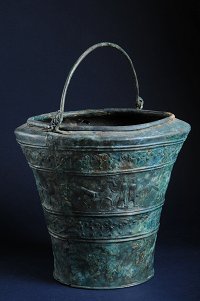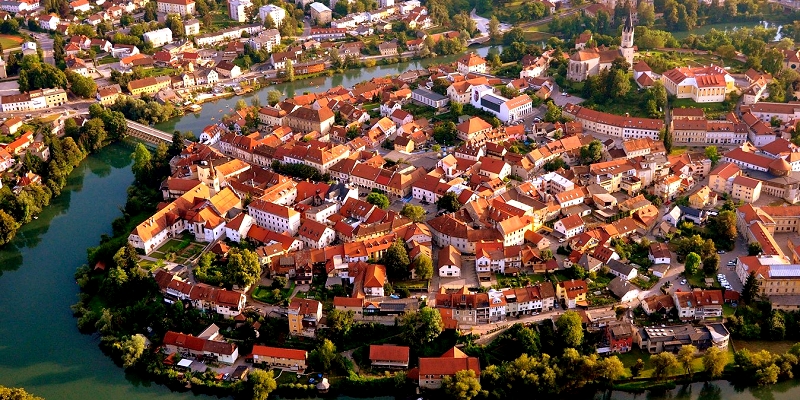About Novo mesto
Among Dolenjska hills, less than an hour's drive by motorway from Ljubljana and Zagreb, less than two hours from the sea and the Alps, lies Novo mesto. Surrounded by the Krka River it lies casually only on a panoramic photo. The metropolis of Dolenjska is growing, evolving, looking for new opportunities; in particular, it offers its residents a welcoming environment for both life and work, from hiking in Gorjanci, to the most modern pharmaceutical laboratories.
NOVO MESTO IN BRIEF
The Municipality of Novo mesto (Slovene: Mestna občina Novo mesto) is a municipality in southeastern Slovenia, close to the border with Croatia. There are approximately 37,300 people living in the municipality, with over 23,000 living in the town of Novo mesto that is the seat of the municipality. Novo mesto is the seventh largest town in Slovenia and the Municipality of Novo mesto is one of the eleven Urban Municipalities in Slovenia.
Novo mesto is the administrative, economic, ecclesiastical, cultural, educational, medical and sports centre of the Southeast Region of Slovenia. It is a hub of plentiful activities, which goes far beyond the regional framework.
It is recognisable by its exceptionally successful pharmaceutical, automotive, construction, textile and other industries, as the municipality is home to large companies such as Krka, Revoz, Adria Mobil and TPV. That is why Novo mesto is called “the export capital of Slovenia”.
The rich archaeological sites in Novo mesto have also made it known as Novo mesto – The Town of Situlae. Together with five other Slovenian towns Novo mesto was the European Capital of Culture 2012.
HISTORY AND HERITAGE
Historical frames are necessary in order to understand the present and optimistically look into the future. 
In the Middle Ages, Novo mesto was marked by Turkish incursions. An important line of defense against this danger took place right across the Krka valley, where one can still see more or less preserved castles from that period. Novo mesto was surrounded by walls, whose remains are still visible today. Some of these are the picturesque Breg area, part of the medieval wall is preserved in Šance and from this period are the former main entrance to the city - Gorenja (Ljubljanska) gate on one side and Dolenjska (Karlovac) gate on the other side of town.
During this period, Novo mesto was under the administration of the Habsburgs, who were aware of the geostrategic importance of this region in their efforts to extend its influence to the Adriatic Sea. Therefore, Rudolf IV von Habsburg signed a Charter on the rights to the city on 7th of April 1365, for which he earned a representation on the Novo mesto’s coat of arms.
The oldest building in Novo mesto also dates back to the Middle Ages. It is the Saint Nicholas' Chapter Church (Kapitelj), which draws a recognizable skyline with its layout over the old town. The church is an architectural peculiarity with characteristics from different periods. Experts attributed this to historical circumstances, such as lack of money, fires and Turkish incursions. The main feature is a broken longitudinal axis, because the ship is shifted with respect to the sanctuary. Sanctuary is late Gothic, ship is early Gothic and the belfry is neo-Gothic. The main attraction is the painting of of St. Nicholas, which was taken by the famous Italian Renaissance painter Tintoretto and is located in the interior. Today, the Chapter Church is also the seat of the diocese of Novo mesto.
Franciscan monks from Bela Krajina fled from the Turks in the Middle Ages and sought refuge in the city, and so another church was built. The Franciscan monastery with the church of Sv. Leonard boasts a high-quality monastery library and the Franciscans left a special mark on the city by running the gymnasium, which was founded by Empress Maria Theresa in 1746.
A few kilometers from the city center stands another medieval monument - the only Slovenian river castle, Castle Otočec. The river Krka’s riverbed was adapted for defense purposes, so that the castle was protected by water on all sides. Today, the castle is a hotel for wealthy guests and the idyllic backdrop of the river island castle is used by many for their wedding ceremony.
THE MUNICIPALITY TODAY
Today, Novo mesto is, in all respects, the center of southeastern Slovenia. Its main attributes in the economic sphere are the internationally recognized companies Krka, Revoz, Adria Mobil and TPV. They take their employees from Novo mesto’s educational institutions, since it is also the center of the wider Dolenjska region when it comes to high schools, and it is also developing its higher education.

We constantly strive to enable the employers from our municipality to choose from a wide range of high-quality staff, that is why education plays an important role in our vision of the town. Nine primary schools, the renowned tradition of our secondary grammar school, the large School Centre and the state-of-the-Art Centre for Biotechnology and Tourism, have been in recent years joined by other institutions of higher education and, there are also increasingly expressed aspirations to establish a university.
COMFORTABLE ENVIRONMENT FOR LIVING, LEARNING AND WORKING
 What is also important for the quality of life is the time that our residents spend outside work or school. In the fields of culture, sports and entertainment, we have focused on the revitalization of the town centre, which gives the events organized in the old town a special charm, whether it be wide od range of cultural festivals and events or jumps in the Krka River from the Kandija bridge.
What is also important for the quality of life is the time that our residents spend outside work or school. In the fields of culture, sports and entertainment, we have focused on the revitalization of the town centre, which gives the events organized in the old town a special charm, whether it be wide od range of cultural festivals and events or jumps in the Krka River from the Kandija bridge.
In the future, we will strive to consolidate and upgrade this position in order to create comfortable environment for living, learning and working. To achieve this, the objective of the municipal administration has been providing fast, efficient and professional service for our residents.
STATISTICAL AND OTHER DATA
Name: Novo mesto, old name Rudolfswerth
Founded: 7 April 1365
Founder: Rudolph IV von Habsburg
Municipal holiday: 7 April
Area: 236 km² (municipality); 30.3 km² (town)
Forest area: 97.239 km²
Highest peak: Trdinov vrh (1,178 metres above sea level)
Altitude: from 164 to 220 metres above sea level (Novo mesto)
Population
Population: 38.198
Density of population: 160
Average age: 42.3 years
Percentage of population with access to:
drinking water 93 %
cleaning plant 55 %
community services 60 %
municipal cleansing service 100 %
gas supply 30 %
Work, Unemployment
Active working population: 14 858
Registered unemployed people: 1741
Level of registered unemployment: 10.5
Agriculture
no. of agricultural holdings: 1121
Economy
Regional GDP per capita: 16 672
Quality of Life (nubmeo.com)
1153 EUR – average net salary (highest in Slovenia)
333 EUR – monthly cost of renting one-bedroom apartment in the centre
173 EUR – monthly cost of living in an 85 m2 apartment
2.20 EUR – average price of beer by a local producer
9 EUR – price of the meal in an inexpensive restaurant
1.25 EUR – cappuccino or bottled water
0.80 EUR – public transport ticket
1 EUR – taxi fare 1km




